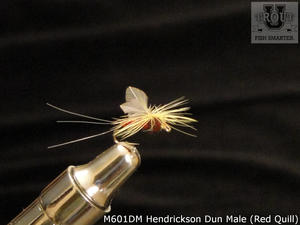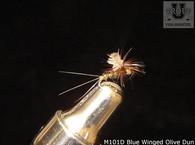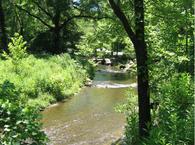
When fly fishing and there is no hatch occuring, look for the trout to be in the slower water. Trout do not always feed in the faster moving water, as they very often feed in the slow to moderately flowing water near the bottom. In very cold water, the trout will almost always be found feeding in the slower moving water in the lower or bottom sections of the stream. This helps them conserve their energy ensuring that they do not expend more energy than the energy derived from the food.
When there is no significant hatch occurring, the browns will eat crawfish, minnows and sculpins in the slow to moderately flowing water on the bottom of the stream. Often times they will be in undercuts, behind rocks or other places where they can rest while waiting to attack food. Terrestrials, however, are eaten wherever they hit the surface of the water which is normally near the banks where the water is somewhat slower.
However when a hatch is occuring, most of the aquatic insects will move towards slower moving water to commence the hatch. Mayfly clingers will leave the fast water runs and riffles and move to the slow moving water found in pockets and shallow water near banks. Almost all of the mayfly crawlers and swimmers move to slow, moderately flowing water to hatch as well. Midges move to the slow moving water found in pools, and calm eddies and the calmer pockets. Caddisflies move to the slow to moderately flowing water for their pupae to emerge. Stoneflies migrate from their fast water habitat through the slower, shallower water to hatch on the banks and rocks. Spinners will fall in the riffles and the runs where they are hatched but soon wash down to the slow flowing water at the heads of pools or calm pockets where they collect.
Nearly all hatching takes place in slower to moderately slower water that occurs in pockets among faster flowing water, or at the ends of long runs where the water slows down. Once the insect hatches and does not immediately fly away, it will be caught up in fast currents. Blue Quill, Mahogany Dun and many species of Blue-winged Olives, including Eastern Blue-winged Olives are able to leave the water before getting caught up in fast currents. Indeed, most hatching aquatic insects and egg layers do not usually get caught up in the fast currents, but there are some exceptions like the Quill Gordons and March Browns that can get caught in the fast currents prior to departing the water.
Therefore the trout will position themselves in the slow to moderately flowing areas of the streams, or calm pockets, or eddies or at the ends of runs and riffles where they have the opportunity to examine the fly in detail. As we have mentioned before, trout have excellent eyesight up close and can distinguish shades of color. In order not to be rejected by the trout the fly must be a good imitation of the natural insect and it must be presented such that it behaves like a real insect.
It is easy to make a good presentation in the fast moving water, but that may not be the most productive section of the stream. The challenge then is to present the fly in the slow to moderately slow flowing water and it must be presented with a good drift, without alarming the trout by the action of the tippet, leader or fly line.





